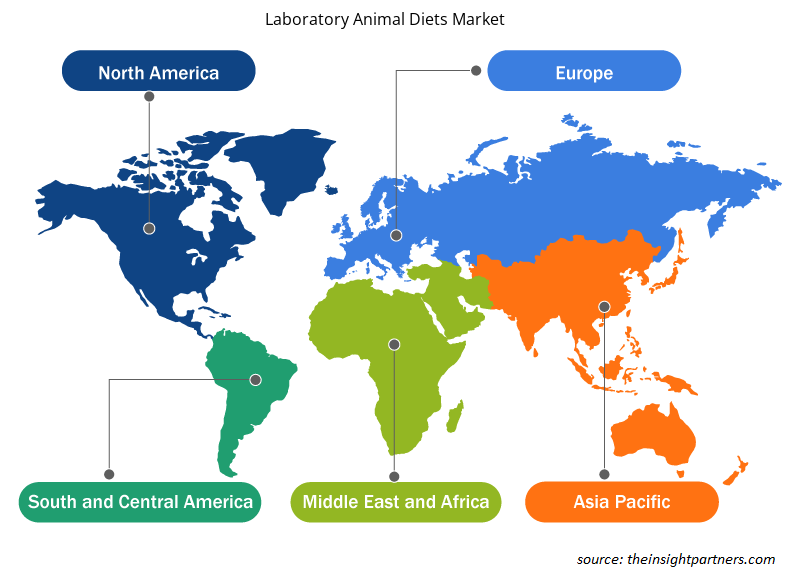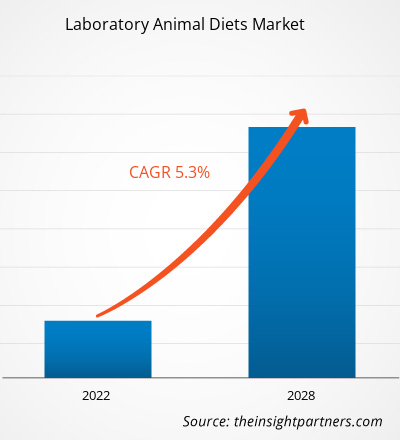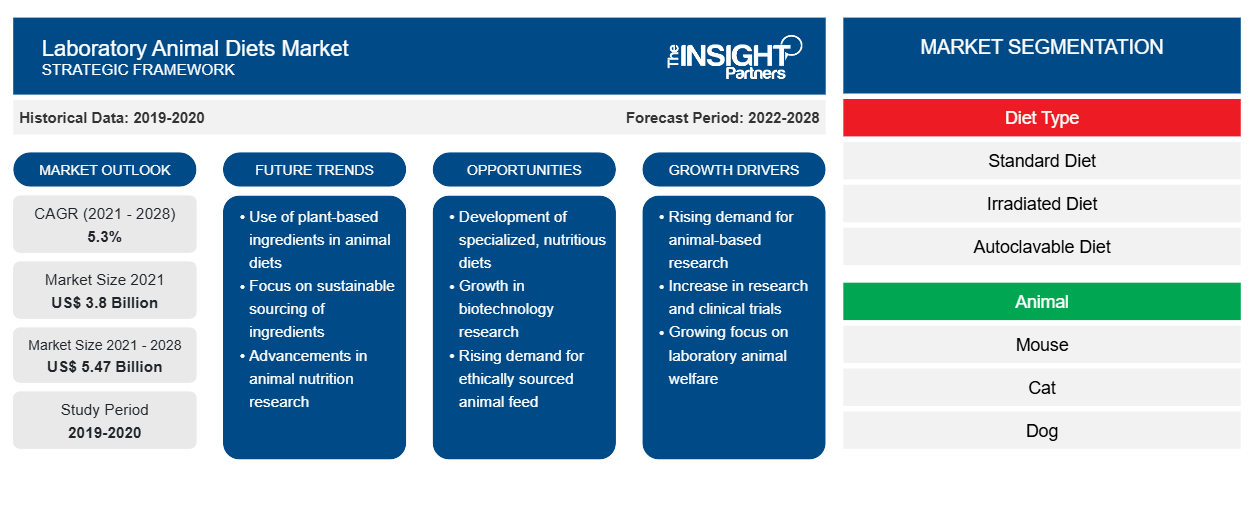Si prevede che il mercato delle diete per animali da laboratorio crescerà da 3.797,50 milioni di dollari nel 2021 a 5.469,24 milioni di dollari entro il 2028; si stima che crescerà a un CAGR del 5,3% dal 2022 al 2028.
Il crescente consumo di medicinali personalizzati è uno dei principali fattori che guidano la crescita del mercato delle diete per animali da laboratorio . Tuttavia, l'elevato costo delle diete per animali da laboratorio frena la crescita della crescita complessiva del mercato.
Secondo la Food and Drug Administration (FDA), la medicina personalizzata mira ad aumentare i benefici e ridurre i rischi per i pazienti, prendendo di mira la prevenzione e il trattamento in modo più efficace. L'applicazione pratica della medicina personalizzata dipende in larga misura dalla disponibilità di rigorosi strumenti diagnostici che consentono la selezione ottimale di prodotti terapeutici per migliorare i risultati per i pazienti.
Le medicine personalizzate sono trattamenti basati sull'ambiente, sulla composizione biologica unica del paziente e sullo stile di vita. Le aziende si concentrano sull'introduzione di nuove diagnosi di accompagnamento per vari tipi di cancro. Ad esempio, nell'ottobre 2020, Roche ha ricevuto l'approvazione della FDA statunitense per le rivendicazioni estese del Cobas EGFR Mutation Test v2 come (CDx) per il trattamento del carcinoma polmonare non a piccole cellule (NSCLC). Pertanto, l'approvazione della FDA di un approccio così nuovo e innovativo potrebbe aprire la strada all'identificazione del paziente per la medicina personalizzata.
Personalizza questo report in base alle tue esigenze
Riceverai la personalizzazione gratuita di qualsiasi report, comprese parti di questo report, o analisi a livello nazionale, pacchetto dati Excel, oltre a usufruire di grandi offerte e sconti per start-up e università
-
Scopri le principali tendenze di mercato in questo rapporto.Questo campione GRATUITO includerà analisi di dati che spaziano dalle tendenze di mercato alle stime e alle previsioni.
Le medicine personalizzate sono concetti, pratiche o modalità che prevedono espressamente la risposta umana a farmaci e malattie in base a differenze intraspecifiche. Piccole differenze nella composizione genetica possono causare differenze drammatiche nella risposta a farmaci o malattie. I ricercatori aiutano a sviluppare approcci alle medicine personalizzate per molti disturbi genetici. Queste medicine personalizzate a volte utilizzano interventi genetici personalizzati, come l'esone saltato mediato da antisenso o l'editing del genoma, per ripristinare la funzione proteica in modo specifico per mutazione. Nella scoperta e nello sviluppo di farmaci, i modelli di topi hanno svolto un ruolo essenziale caratterizzando la fisiopatologia delle malattie e i meccanismi di lesione associati; identificando i bersagli dei farmaci; e valutando nuove terapie per tossicità/sicurezza, farmacocinetica, farmacodinamica ed efficacia. La selezione di un modello specifico per la sperimentazione e lo sviluppo di un farmaco particolare dipende dall'obiettivo dello studio approfondito.
L'uso tradizionale di modelli animali nella scoperta di farmaci stabilisce e dimostra la prova di concetto non clinica per la sicurezza, l'efficacia e il target di interesse di specifiche molecole di farmaci. I modelli animali possono facilitare lo sviluppo di approcci di medicina personalizzata. Gli approcci di medicina personalizzata devono essere sviluppati e testati preclinicamente in modelli cellulari e di topi pertinenti contenenti le sequenze target umane. I modelli animali utilizzati per la ricerca sulla medicina personalizzata e la scoperta e lo sviluppo di farmaci sono forniti di diete specifiche in modo che il modello animale reagisca in base all'ambiente umano. Pertanto, si prevede che la crescente domanda di medicinali personalizzati alimenterà la crescita del mercato delle diete per animali da laboratorio nel periodo 2022-2028.
Panoramica regionale
La Cina detiene una quota considerevole nel mercato delle diete per animali da laboratorio dell'Asia Pacifica. La Cina ha accesso a enormi colonie di scimmie e altre specie. Pertanto, gli scienziati nel paese affrontano meno ispezioni pubbliche rispetto all'Europa e agli Stati Uniti. La Cina è diventata il centro del regno animale CRISPR, che è attraente per i ricercatori. Inoltre, il governo cinese ha massicci investimenti in nuovi servizi e determinati progetti di ricerca. La ricerca sugli animali nel paese è regolamentata e gestita amministrativamente secondo leggi, regolamenti, linee guida e standard nazionali e provinciali. La scienza degli animali da laboratorio in Cina si è sviluppata rapidamente negli ultimi 30 anni grazie alle forze governative e sociali, che stanno incoraggiando i progetti di ricerca nel paese. Secondo l'Institute of Laboratory Animal Sciences (ILAS), la Cina utilizza circa 20 milioni di animali, come topi, cani, conigli e primati non umani, nella ricerca ogni anno. Pertanto, si prevede che l'aumento della ricerca biomedica che utilizza animali da laboratorio guiderà il mercato delle diete per animali da laboratorio durante il periodo di previsione.
Approfondimenti sul tipo di dieta
In base al tipo di dieta, il mercato delle diete per animali da laboratorio è suddiviso in dieta standard, dieta irradiata e dieta autoclavabile. Il segmento della dieta standard ha detenuto la quota maggiore del mercato nel 2021. La dieta standard è formulata per soddisfare obiettivi generali in tutte le fasi della vita coinvolte nell'alimentazione degli animali da laboratorio, ovvero i nutrienti che sono in genere necessari per gli animali da laboratorio sono già presenti nella dieta standard. Ad esempio, la dieta canina LabDiet soddisfa i requisiti nutrizionali di tutte le specie canine utilizzate in laboratorio e supporta tutte le fasi della vita, come crescita, mantenimento, gestazione e allattamento. Inoltre, l'Università dell'Alabama a Birmingham ha pubblicato un rapporto nel 2022 affermando che il mantenimento della salute degli animali è fondamentale per scopi di ricerca, con una buona nutrizione come componente chiave della salute. Le diete standard comprendenti ingredienti noti sono disponibili per i roditori. Tuttavia, le diete nutrizionalmente complete (o sazie) non sono disponibili in commercio per alcune specie di laboratorio. Pertanto, le principali aziende stanno sviluppando un'alimentazione standard per animali. Ad esempio, la dieta standard di Envigo comprende materie prime agricole relativamente indefinite come cereali, sottoprodotti dei cereali, fonti concentrate di proteine vegetali, proteine animali, vitamine, minerali e grassi. Pertanto, i fattori sopra menzionati sono responsabili dell'accelerazione dell'adozione della dieta standard, guidando in ultima analisi la crescita complessiva del mercato delle diete per animali da laboratorio.autoclavable diet. The standard diet segment held the largest share of the market in 2021. The standardi.e., the nutrients that are in general needed for lab animals are already present in the standard diet.LabDiet canine diet meets the nutritional requirements of all canine species utilized in a laboratory and supports all life stages, such as growth, maintenance, gestation, and lactation. Further, the University of Alabama at Birmingham published a report in 2022 stating that maintaining animal health is critical intended for research purposes, with good nutrition as a key component of health. Standard diets comprising known ingredients are available for rodents. However, nutritionally complete (or replete) diets are not commercially available for some laboratory species. Therefore, top companies are developing standard animal feeding. For example, Envigo's standard diet comprises relatively undefined agricultural commodities such as grains, grain by-products, concentrated plant protein sources, animal proteins, vitamins, minerals, and fats. Thus, the aforementioned factors are responsible for accelerating the adoption of standard diet, ultimately driving the overall laboratory animal diets market growth.
Le aziende che operano nel mercato delle diete per animali da laboratorio adottano la strategia di innovazione del prodotto per soddisfare le mutevoli esigenze dei clienti in tutto il mondo, il che consente loro anche di mantenere il proprio marchio sul mercato.
Approfondimenti regionali sul mercato delle diete per animali da laboratorio
Le tendenze regionali e i fattori che influenzano il mercato delle diete per animali da laboratorio durante il periodo di previsione sono stati ampiamente spiegati dagli analisti di Insight Partners. Questa sezione discute anche i segmenti e la geografia del mercato delle diete per animali da laboratorio in Nord America, Europa, Asia Pacifico, Medio Oriente e Africa e Sud e Centro America.

- Ottieni i dati specifici regionali per il mercato delle diete per animali da laboratorio
Ambito del rapporto di mercato sulle diete per animali da laboratorio
| Attributo del report | Dettagli |
|---|---|
| Dimensioni del mercato nel 2021 | 3,8 miliardi di dollari USA |
| Dimensioni del mercato entro il 2028 | 5,47 miliardi di dollari USA |
| CAGR globale (2021 - 2028) | 5,3% |
| Dati storici | 2019-2020 |
| Periodo di previsione | 2022-2028 |
| Segmenti coperti |
Per tipo di dieta
|
| Regioni e Paesi coperti |
America del Nord
|
| Leader di mercato e profili aziendali chiave |
|
Densità degli attori del mercato delle diete per animali da laboratorio: comprendere il suo impatto sulle dinamiche aziendali
Il mercato delle diete per animali da laboratorio sta crescendo rapidamente, spinto dalla crescente domanda degli utenti finali dovuta a fattori quali l'evoluzione delle preferenze dei consumatori, i progressi tecnologici e una maggiore consapevolezza dei benefici del prodotto. Con l'aumento della domanda, le aziende stanno ampliando la propria offerta, innovando per soddisfare le esigenze dei consumatori e capitalizzando sulle tendenze emergenti, il che alimenta ulteriormente la crescita del mercato.
La densità degli operatori di mercato si riferisce alla distribuzione di aziende o società che operano in un particolare mercato o settore. Indica quanti concorrenti (operatori di mercato) sono presenti in un dato spazio di mercato in relazione alle sue dimensioni o al valore di mercato totale.
Le principali aziende che operano nel mercato delle diete per animali da laboratorio sono:
- Envigo
- Altromin Spezialfutter GmbH & Co. KG
- Dieta di laboratorio
- SICURO
- Coloranti, Inc.
Disclaimer : le aziende elencate sopra non sono classificate secondo un ordine particolare.

- Ottieni una panoramica dei principali attori del mercato delle diete per animali da laboratorio
Mercato delle diete per animali da laboratorio – Segmentazione
- In base all'animale, il mercato delle diete per animali da laboratorio è segmentato in topi, gatti, cani, conigli, polli e altri. Il segmento dei topi ha detenuto la quota maggiore del mercato nel 2021 e si prevede che registrerà il CAGR più elevato durante il periodo di previsione.
- In base all'applicazione, il mercato delle diete per animali da laboratorio è segmentato in scoperta di farmaci e medicina personalizzata, medicina rigenerativa, patologia delle malattie infettive, test di tossicità ed efficacia dei farmaci e altri. Il segmento scoperta di farmaci e medicina personalizzata ha detenuto la quota maggiore del mercato nel 2021. Tuttavia, si prevede che il segmento patologia delle malattie infettive registrerà il CAGR più elevato durante il periodo di previsione.
- In base all'utente finale, il mercato delle diete per animali da laboratorio è segmentato in aziende farmaceutiche e biofarmaceutiche, istituti di ricerca e accademici e altri. Il segmento delle aziende farmaceutiche e biofarmaceutiche ha detenuto la quota maggiore del mercato nel 2021. Tuttavia, si prevede che il segmento degli istituti di ricerca e accademici registrerà il CAGR più elevato durante il periodo di previsione.
- In base all'area geografica, il mercato delle diete per animali da laboratorio è segmentato in Nord America (Stati Uniti, Canada e Messico), Europa (Regno Unito, Germania, Francia, Italia, Spagna e resto d'Europa), Asia Pacifico (Cina, Giappone, India, Australia, Corea del Sud e resto dell'Asia Pacifico), Medio Oriente e Africa (Emirati Arabi Uniti, Arabia Saudita, Sudafrica e resto del Medio Oriente e dell'Africa) e Sud e Centro America (Brasile, Argentina e resto del Sud e Centro America).
Envigo; Altromin Spezialfutter GmbH & Co. KG; LabDiet; SAFE; Dyets, Inc.; Special Diet Services; Specialty Feeds; Research Diet Inc.; Bio-Serv; e Krishna Valley Agrotech LLP. Sono tra le principali aziende che operano nel mercato delle diete per animali da laboratorio.
- Analisi storica (2 anni), anno base, previsione (7 anni) con CAGR
- Analisi PEST e SWOT
- Valore/volume delle dimensioni del mercato - Globale, Regionale, Nazionale
- Industria e panorama competitivo
- Set di dati Excel
Report recenti
Rapporti correlati
Testimonianze
Motivo dell'acquisto
- Processo decisionale informato
- Comprensione delle dinamiche di mercato
- Analisi competitiva
- Analisi dei clienti
- Previsioni di mercato
- Mitigazione del rischio
- Pianificazione strategica
- Giustificazione degli investimenti
- Identificazione dei mercati emergenti
- Miglioramento delle strategie di marketing
- Aumento dell'efficienza operativa
- Allineamento alle tendenze normative























 Ottieni un campione gratuito per - Mercato delle diete per animali da laboratorio
Ottieni un campione gratuito per - Mercato delle diete per animali da laboratorio